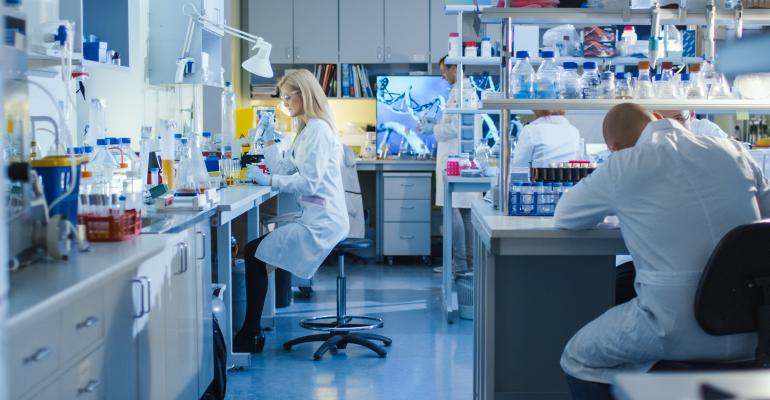With demand for office space somewhat anemic right now, many office landlords are considering repositioning their office buildings as life science lab space, especially in premier biomedical research markets, including Boston-Cambridge, the San Francisco Bay Area and San Diego.
Office-to-lab conversions are currently a hot trend in the Boston-Cambridge market, according to Boston-based Robert Richards, who leads the Cambridge/Urban team at real estate services firm Cushman & Wakefield. “Demand for biomedical lab space is insatiable right now and will remain in high demand for next 24—36 months in the Boston-Cambridge metro,” he says, noting that when the 2 to 3 million sq. ft. of new lab space under construction is delivered in 2023 and 2024 this sector is expected to soften a little.
In fact, with demand for lab space so strong right now and vacancy at 5.0 percent for a decade, the life sciences sector the Boston metro is expanding beyond traditional boundaries, with lab conversions now common in the Watertown, Somerville, Lexington and Waltham submarkets, as developers and office owners see strong value and stable long-term demand for the product, Richards adds. He notes that conversion projects are trading in the $1,700 to $1800 per sq. ft. range.
“Lab rents in the Boston area are over $100 per sq. ft., so there is tremendous upside opportunities in conversions,” Richards says, noting that another positive dynamic in this sector is that life science companies grow at a rapid pace, commonly doubling or tripling in size within 24-36 months.
Additionally, most of these tenants look at seven- to 10-year lease deals, with the more established companies signing up for 15 years. Since the investment to convert buildings to lab space and offer tenant improvements can total more than $300 per sq. ft., according to Richards, so landlords require long-term leases to amortize expenses to operating income.
According to real estate services firm CBRE, venture capital investment in U.S. life science companies for the year ending in the second quarter of 2020 reached a record high of $17.8 billion. But while the COVID-19 pandemic and push for vaccine development has had a positive impact on this sector, Richards says that the effect has been minimal compared to the tailwinds building in this space for a number of years. He notes that capital investment for real estate conversions, which is expected to be robust over the next 24 to 36 months, continues to come from all investor segments, from pension funds and REITs to private funds and foreign investors.
The Boston metro is not the only market experiencing a spike in office-to-lab conversions, notes Richards, who also heads Cushman & Wakefield’s life sciences and healthcare practice group nationally. Similar repositionings are happening in the other premier life sciences markets, including the San Francisco Bay Area, San Diego, and the Raleigh-Durham Research Triangle.
In addition, in growing life sciences markets like Philadelphia and Seattle, where demand is not as strong or broad as in the traditional biomedical research hubs, lab requirements are being met with office-to-lab conversions rather than new construction. says Ian Anderson, CBRE senior director of research & analysis for the Greater Philadelphia Region.
Owners of conventional offices are examining their options for lab conversions, he continues. The degree of demand for lab space in a market correlates with interest in converting conventional office buildings, so lab conversion activity is more intense in Boston than in a market like Philadelphia, Anderson adds.
Generally speaking, whether lab conversions make sense in a market comes down to available space, land constraints and demand, Anderson says, noting that those three components are strongest in premier life sciences markets: Boston-Cambridge, the Bay Area, and San Diego.
“These markets have natural supply constraints in terms of land, as well as very strong high-tech sectors and robust economies, and are the top centers for U.S. life sciences research, so demand for space continues to exceed supply, forcing developers to convert existing properties.”
Flex industrial and office properties are prime candidates for conversions to lab space, especially because their higher ceiling heights can accommodate sophisticated equipment, Anderson notes. But Richards warns that not all of these building types can be adapted to life science purposes, noting there are very specific infrastructure and structural requirements for lab space.
A report from design firm Gensler details these considerations, which include:
- Zoning and code compliance: a change in occupancy or use may require changes or upgrades in egress systems and fire protection measures, as well as new entitlement approvals to make building modifications, such as changes in external façade for better ventilation or installation of power plants on intermediate floors. In addition, there is a need to provide sufficient loading dock and utility yard space to receive, store, distribute, and dispose of hazardous materials.
- Structural requirements: column spacing of ideally 11 feet; floor-to-roof loads capable of supporting 100 pounds per sq. ft.; floor vibration stability to accommodate use of sensitive microscopy equipment; and floor-to-ceiling height clearance of 14 to 16 ft. to accommodate special equipment used in research.
- Building infrastructure: efficient HVAC and ventilation and exhaust systems to provide environmental safety and cleanliness; electrical service that provides twice the power of a typical office building; and a standby power generator to protect critical infrastructure systems, ongoing research and sensitive products.
The Gensler report authors, architects David Bendet, Darrel Fullbright, and Justin Cratty, also noted that marrying the aspects of an existing building with the unique specifications for science facilities and user organizations that occupy them is another key challenge conversion projects need to address.
They said that in a build-to-suit the conversion can be developed around the specific needs of the user, while also considering future adaptability. But speculative lab conversions present a greater challenge, requiring “test-fit iterations aligned with target tenant types and the most likely set of science uses.”

